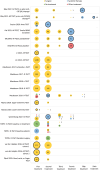The economic and humanistic burden of tenosynovial giant cell tumor: a targeted literature review
- PMID: 40545745
- PMCID: PMC12323415
- DOI: 10.1080/14796694.2025.2520744
The economic and humanistic burden of tenosynovial giant cell tumor: a targeted literature review
Abstract
Aim: To understand the epidemiology, treatment patterns, economic burden, and humanistic burden of tenosynovial giant cell tumor (TGCT) in the contemporary treatment landscape.
Methods: Embase, MEDLINE, and select conferences were searched to identify studies published between 1 January 2013, and 22/23 August 2023 (database dependent) that included ≥ 20 TGCT patients (≥ 40 for humanistic burden studies). For economic outcomes and treatment patterns, data from 1 January 2008, and later were included.
Results: A total of 35 studies were included. The incidence of TGCT was < 50 cases/million person-years. Surgery was the most common treatment, for which recurrence rates were up to 67%. While quality of life improved after surgery in the absence of recurrence, repeat surgeries for persistent symptoms or recurrent tumors negatively impacted quality of life and inflicted a high economic burden. Systemic therapies were effective and overall improved patient symptoms and quality of life. Treatment was multidisciplinary and involved orthopedic surgeons and medical oncologists as well as supplemental care such as physical therapy.
Conclusion: TGCT has a high burden, which can be exacerbated by repeat surgeries. Systemic therapies may improve disease and quality of life outcomes in some patients with tumors that are locally advanced or in complicated anatomical locations.
Keywords: CSF1R; PVNS; TGCT; cost; orthopedic surgery; patient-reported outcomes; quality of life; treatment patterns.
Plain language summary
Tenosynovial giant cell tumor (TGCT) is a rare disease that affects the joints and surrounding tissues. We reviewed published studies to understand how common TGCT is, current treatments, healthcare-related services and costs, and its impact on patients. Studies confirmed that TGCT is rare and that it impacts a relatively young population. Patients with TGCT commonly experience pain and stiffness and have less mobility and worse overall quality of life compared with the general population. Most patients with symptoms are treated with surgery. However, TGCT can come back after surgery in up to 2 out of 3 patients, potentially requiring them to undergo additional surgeries, which may be expensive and worsen symptoms. Alternatively, medications can be used for treatment and improve symptoms and quality of life for many patients. However, medications are not currently widely available and some are associated with negative side effects. More studies on existing medications and new medications that have fewer side effects are needed. In addition to surgery and medications, many patients receive physical therapy. Treatment decisions should consider the risks and benefits of all options on an individual basis.
Figures
Similar articles
-
Prescription of Controlled Substances: Benefits and Risks.2025 Jul 6. In: StatPearls [Internet]. Treasure Island (FL): StatPearls Publishing; 2025 Jan–. 2025 Jul 6. In: StatPearls [Internet]. Treasure Island (FL): StatPearls Publishing; 2025 Jan–. PMID: 30726003 Free Books & Documents.
-
What Are the Recurrence Rates, Complications, and Functional Outcomes After Multiportal Arthroscopic Synovectomy for Patients With Knee Diffuse-type Tenosynovial Giant-cell Tumors?Clin Orthop Relat Res. 2024 Jul 1;482(7):1218-1229. doi: 10.1097/CORR.0000000000002934. Epub 2023 Dec 28. Clin Orthop Relat Res. 2024. PMID: 38153106 Free PMC article.
-
A rapid and systematic review of the clinical effectiveness and cost-effectiveness of paclitaxel, docetaxel, gemcitabine and vinorelbine in non-small-cell lung cancer.Health Technol Assess. 2001;5(32):1-195. doi: 10.3310/hta5320. Health Technol Assess. 2001. PMID: 12065068
-
A rapid and systematic review of the clinical effectiveness and cost-effectiveness of topotecan for ovarian cancer.Health Technol Assess. 2001;5(28):1-110. doi: 10.3310/hta5280. Health Technol Assess. 2001. PMID: 11701100
-
Systemic treatments for metastatic cutaneous melanoma.Cochrane Database Syst Rev. 2018 Feb 6;2(2):CD011123. doi: 10.1002/14651858.CD011123.pub2. Cochrane Database Syst Rev. 2018. PMID: 29405038 Free PMC article.
References
-
- Molena B, Sfriso P, Oliviero F, et al. Synovial colony-stimulating factor-1 mRNA expression in diffuse pigmented villonodular synovitis. Clin Exp Rheumatol. 2011. May;29(3):547–550. - PubMed
-
- Stacchiotti S, Durr HR, Schaefer IM, et al. Best clinical management of tenosynovial giant cell tumour (TGCT): a consensus paper from the community of experts. Cancer Treat Rev. 2023. Jan;112:102491. doi: 10.1016/j.ctrv.2022.102491. - DOI - PubMed
-
•• A global consensus paper on the best clinical management of TGCT involving experts from several disciplines and patient representatives to define an evidence-based approach for TGCT treatment.
Publication types
MeSH terms
Grants and funding
LinkOut - more resources
Full Text Sources
Other Literature Sources
Miscellaneous


